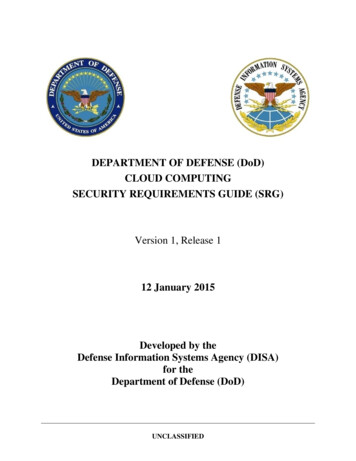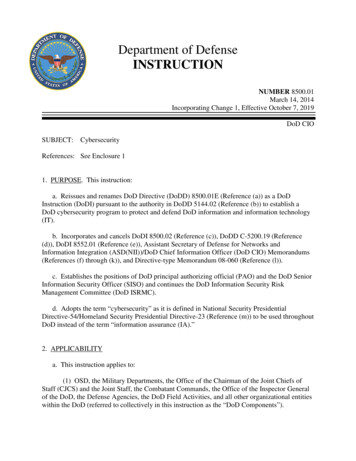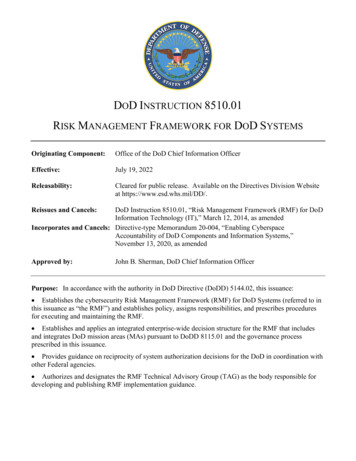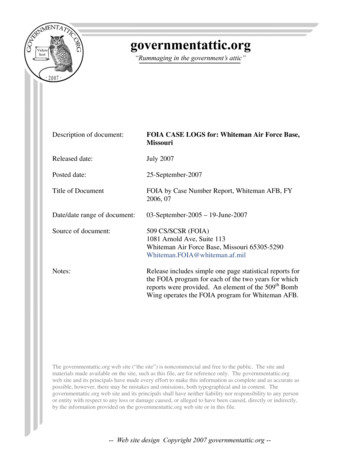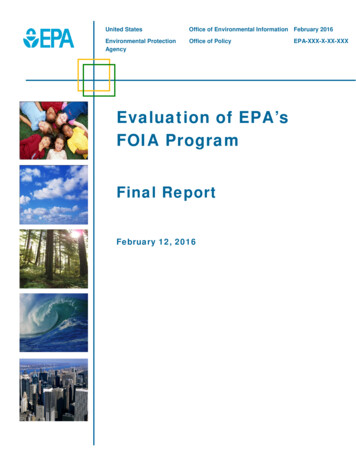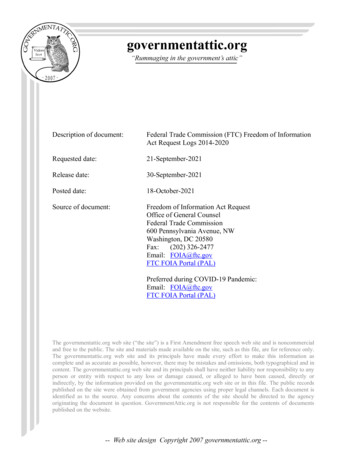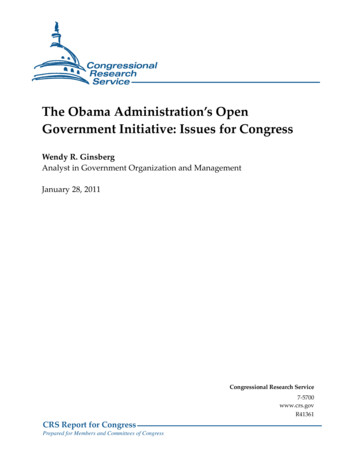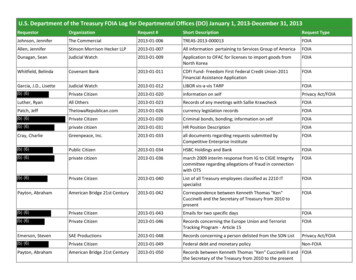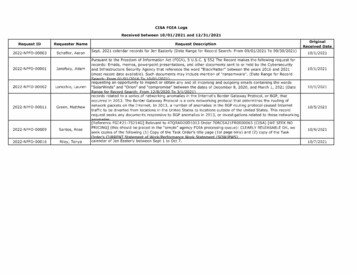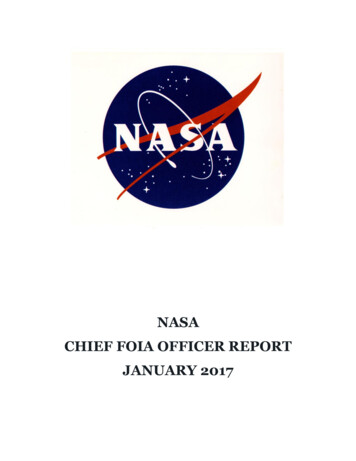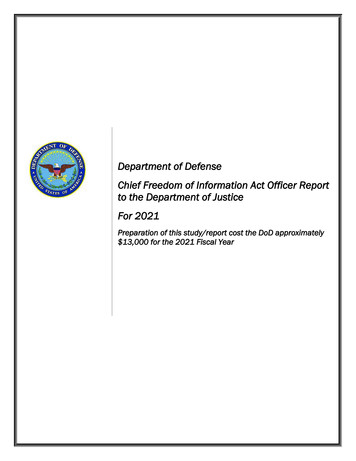
Transcription
Department of DefenseChief Freedom of Information Act Officer Reportto the Department of JusticeFor 2021Preparation of this study/report cost the DoD approximately 13,000 for the 2021 Fiscal Year
Table of ContentEXECUTIVE SUMMARY .I1.0 STEPS TAKEN TO APPLY THE PRESUMPTION OF OPENNESS.11.1 FOIA TRAINING . 11.2 OUTREACH. 31.3 OTHER INITIATIVES . 32.0 STEPS TAKEN TO ENSURE THAT DOD HAS AN EFFECTIVE SYSTEM IN PLACEFOR RESPONDING TO REQUESTS . 52.1 PROCESSING PROCEDURES. 52.2 REQUESTER SERVICES . 73.0 STEPS TAKEN TO INCREASE PROACTIVE DISCLOSURES. 103.1 POSTING MATERIAL . 103.2 OTHER INITIATIVES . 134.0 STEPS TAKEN TO GREATER UTILIZE TECHNOLOGY. 134.1 LEVERAGING TECHNOLOGY . 134.2 OTHER INITIATIVES . 145.0 STEPS TAKEN TO IMPROVE TIMELINESS IN RESPONDING TO REQUESTSAND REDUCING BACKLOGS . 145.1 SIMPLE TRACK . 145.2 BACKLOGS . 155.3 BACKLOG REDUCTION PLANS . 175.4 STATUS OF TEN OLDEST REQUESTS, APPEALS, AND CONSULTATIONS . 185.5 ADDITIONAL INFORMATION ON TEN OLDEST REQUESTS, APPEALS AND CONSULTATIONS &PLANS. 196.0 SUCCESS STORY . 21
2021 Department of DefenseChief Freedom of Information Act (FOIA) Officer Report to theDepartment of JusticeExecutive SummaryThe 2009 Department of Justice’s (DOJ) Freedom of Information Act (FOIA) Guidelines requirethe Chief FOIA Officer for each federal agency to submit a report to the Attorney Generalcontaining a detailed description of the steps undertaken by the agency to improve FOIAcompliance and transparency. This year’s report covers the period from March 13, 2020 to March12, 2021.As the Interim Director of Administration and Management, I also serve as the DoD Chief FOIAOfficer. I am pleased to submit the 2021 Department of Defense (DoD) Chief FOIA OfficerReport to the Department of Justice. As the DoD Chief FOIA Officer, I am continuing the DoDtradition of leadership dedication to the success of the Department’s FOIA program through the 33FOIA Requester Service Centers (DoD Components listed below) located around the world.On my behalf, the Directorate for Oversight and Compliance (DO&C) within the Office of theAdministration and Management, oversees all FOIA policy matters within the DoD. Through theDO&C, I ensure ongoing emphasis on FOIA including the areas of particular interest to DOJ inthis year’s report: applying the presumption of openness, effective systems for responding torequests, increasing proactive disclosures, increasing greater utilization of technology, and improvingtimeliness. This report encompasses the efforts and results of DO&C and the 33 DoDComponents.The DoD has a decentralized FOIA program, with each of the 33 DoD Components implementingtheir own FOIA programs. The DO&C provides overall DoD FOIA guidance to the DoDComponents, helping them ensure that their processes comply with the FOIA, relevant case law,and DoD policy. The DoD Components are, in turn, responsible for establishing and maintainingFOIA processes uniquely tailored to their organizations while providing the best quality customerservice possible.During Fiscal Year (FY) 2020, DoD Components processed over 50,000 FOIA requests, and 89%of all received requests in FY20 were processed in less than 100 days. DoD Components remainedattuned to public interest, but still faced some challenges. Only 15% of the components closed allof their ten oldest requests and there was an increase of the overall appeals backlog by 7% this fiscalyear.The 2021 DoD Chief FOIA Officer report details how DoD has continued to improve itsadministration of the FOIA and strengthen initiatives to further streamline our FOIA processes.Some of the key highlights in this report include details regarding DoD Components vigilance inattending and hosting FOIA training to ensure that FOIA professionals are well versed in thenuances of FOIA intricacies. Components are striving to reach more agency non-FOIAprofessionals through creative outreach methods, improve overall program efficiencies and providespecific items of most interest to their requester communities.i
All DoD Components are focused on enhancing customer service and communications with FOIArequesters. Many report that public facing electronic tools assist requesters with tracking requests,monitoring progress towards case fulfillment, and finding released records with greater ease. Theyalso report a variety of initiatives and steps undertaken to ensure that their FOIA systems areoperating efficiently and effectively.I am proud of the efforts of the Department to improve FOIA processes and look forward to theDepartment’s continued work enhancing and promoting the principles of openness tally signed byMUIR.THOMAS.MICHAEL.1153893256Date: 2021.03.04 08:24:39 -05'00'Thomas M. MuirInterim DirectorAdministration and Managementii
DoD Components/33 FOIA Request Service CentersAIR FORCEDepartment of the Air ForceAFRICOMU.S. Africa CommandASBCAArmed Services Board of Contract AppealsARMYDepartment of the ArmyCENTCOMU.S. Central CommandCYBERCOMU.S. Cyber CommandDCAADefense Contract Audit AgencyDCMADefense Contract Management AgencyDCSADefense Counterintelligence and Security AgencyDeCADefense Commissary AgencyDFASDefense Finance and Accounting ServiceDHADefense Health AgencyDIADefense Intelligence AgencyDISADefense Information Systems AgencyDLADefense Logistics AgencyDoDEADepartment of Defense Education ActivityDoD IGDepartment of Defense Inspector GeneralDTICDefense Technical Information CenterDTRADefense Threat Reduction AgencyEUCOMU.S. European CommandJPRAJoint Personnel Recovery AgencyINDO-PACOMU.S Indo-Pacific CommandNAVYDepartment of the NavyNGANational Geospatial-Intelligence Agencyiii
NGBNational Guard BureauNORTHCOMU.S. Northern CommandNRONational Reconnaissance OfficeNSANational Security AgencyOSD/JSOffice of the Secretary of Defense/Joint StaffSOCOMU.S. Special Operations CommandSOUTHCOMU.S Southern CommandSTRATCOMU.S. Strategic CommandTRANSCOMU.S. Transportation Commandiv
1.0 Steps Taken to Apply the Presumption of Openness1.1 FOIA TrainingThe DO&C is the office within DoD responsible for FOIA policy as well as encouraging andpromoting FOIA and Privacy Act (PA) training within the Department. In this capacity, the DO&Cconducts in-person FOIA/PA compliance workshops and virtual training. In February 2020,DO&C conducted a three-day FOIA/PA compliance workshops at the Joint Base Pearl HarborHickam, Hawaii. This training featured expert instructors from multiple DoD Components. FOIAtopics included DoD FOIA policy, the FOIA exemptions, document declassification, fees and feewaivers, litigation considerations, mechanics, and best practices in processing FOIA requests. PAtopics included conditions of disclosure, privacy concerns with information sharing and socialmedia, and system of records notices. A second FOIA/PA compliance workshop was scheduled forApril 2020, at the Mark Center in Alexandria, Virginia, but was cancelled due to COVID-19.The DO&C also continued to provide virtual training through the Joint Knowledge Online (JKO)tool, which is available to DoD personnel world-wide. The JKO tool allows uploading previouslyrecorded material and is the current platform upon which DOJ’s Office of Information Policy (OIP)FOIA training videos are hosted.During this reporting period, 79% of DoD FOIA professionals received formal FOIA training.Over 45% of the DoD Components sent representatives from their FOIA professional staff to theDoD-wide FOIA/PA Training Workshop and to the DO&C Defense Connect Service (DCS)training. Additionally more than 30% of the Components sent personnel to DOJ’s OIP training.Approximately 15% of DoD Components sent personnel to the American Society of AccessProfessionals training, as well as provided internal training. Due to COVID-19, or the lack ofpersonnel, 21% of DoD Components were unable to attend training this year. DoD intends toprovide additional DoD-wide FOIA/PA Training Workshops and strongly encourage Componentsto conduct their own internal trainings to increase the overall percentage of training.1 Page
DoD Professional Attended FOIA .0%5.0%0.0%NONEDOD-WIDE FOIA/PATRAINING WORKSHOPCMO-TO DEFENSECONNECT SERVICE (DCS)DEPARTMENT OFJUSTICEAMERICAN SOCIETY OFACCESS PROFESSIONALSCOMPONENTSPONSOREDThe DoD Components that reported hosting their own training for FOIA professionals provided avariety of venues and methods of substantive teaching regarding applying and implementing FOIA.For example:xThe ARMY conducted a 3-day Records Management-FOIA-Privacy-Civil Liberties VirtualSymposium on 25-27 August 2020. The virtual symposium was conducted with over 1,000participants. FOIA training session addressed FOIA policies and appeal requirements. Thesession also included open discussion on various FOIA issues, policies and best practices.xDoD IG FOIA Office provided training to OIG component FOIA points of contact. Thistraining included best practices in searching for federal records, how to respond to searchtaskings with a voluminous amount of responsive records, and a high-level overview ofpertinent aspects of the FOIA. DoD IG also held virtual internal FOIA training for theGovernment Information Specialists in office. This training reinforced DoD IG’s requestprocessing practices and created an opportunity to review the policies behind the practices.xAIR FORCE, DFAS, DLA, DTRA and OSD/JS offered comprehensive training to theirFOIA professionals and SMEs (Subject Matter Expert) on subjects such as componentpolicies, case processing, FOIA challenges, and openness in government. SMEs are definedas individuals who have special skills or knowledge on a particular function or topic and areroutinely involved in the FOIA process.2 Page
xNAVY conducted several virtual meetings pertaining to its FOIA program and currentFOIA laws and practices. Each session drew an attendance of approximately 200 NAVYpersonnel. NAVY typically hosts a week-long seminar, which was cancelled due to COVID19.1.2 OutreachDuring this reporting period, 75% of the DoD Components reported no engagement in formaloutreach activities with the requester community. However, throughout the year, theseComponents were proactive in contacting individual requesters and engaging in substantiveexchanges designed to more fully educate, explain, and provide specifically detailed information.Some of the smaller Components with low requester volume indicated that the types of recordrequests they received lend themselves to more personalized interactions with requesters from thebeginning of the FOIA process. Smaller staffs result in requesters working with the same FOIAprofessional which facilitates better anticipation of high-demand materials.A few of the DoD Components reported engagement in formal outreach activity. For example:xDoD IG’s FOIA Director is a member of the Technology Committee of the Chief FOIAOfficers (CFO) Council. This group studies the utilization and deployment of technology inFOIA programs across agencies and identifies best practices and recommendations that canbe implemented across agencies. The results are shared with the requester community.xARMY Components continue to work closely with ARMY public affairs offices worldwideand with command related/community outreach groups, ensuring open dialogue to addressgeneral questions, provide feedback on complaints and recommendations, and questionsrelated to FOIA processing and specific FOIA cases. These outreach activities often includespouses of military personnel and veteran outreach programs.xDoDEA worked with the FOIA Public Liaison to arrange a meeting with a frequentrequester to discuss the capabilities of one of its student programs.xDCSA improved the design of its website, which provides the public with information abouthow to submit a FOIA request.1.3 Other InitiativesThe DoD Components reported a variety of methods to inform non-FOIA professionals aboutFOIA and indicated that the most effective tool is senior leadership awareness and reinforcement ofthe importance of FOIA.Similar to last year, the most commonly employed methods for informing non-FOIA professionalsare general FOIA training for all personnel and more detailed training for SMEs. The generaltraining is necessarily broad and introductory in nature while the SME training features detailedguidance on the proper application of FOIA exemptions, with the objective of SMEs understandingboth the FOIA and the particular agency policies.3 Page
For instance:xCENTCOM conducted quarterly meetings and provided SMEs with FOIA policydocumentation. CENTCOM also published a Command Compliance Memorandumreiterating the significance of the FOIA program.xAIR FORCE Senior Leaders and Commanders regularly remind and reaffirm to the Officeof Professional Responsibility (OPR), the AF's commitment to full compliance with theFOIA to mitigate litigation penalties, to support FOIA professionals, and to ensure FOIAprograms are adequately resourced and processes are continually analyzed for improvements.With the ongoing increase in the AF FOIA backlog, senior leadership continually addressesthe historically high AF FOIA backlog with their OPR's to highlight the importance ofproviding responsive documents/records in a timely manner in order to remain compliantwith the law. In addition, AF FOIA office and Requester Service Centers (RSC) providetheir senior leadership monthly FOIA program updates and reiterate their obligations underthe FOIA.xDHA provided four one-on-one trainings for FOIA Liaisons within DHA ProgramOffices. The trainings were done virtually and via email, and included information andguidance for how to conduct records searches and respond to the DHA FOIA ServiceCenter. The trainings also reviewed the responsibilities and requirements for DHA FOIALiaisons.xCYBERCOM provided a 30 minute FOIA presentation at the command’s “Lunch andLearn” series. The objective was to provide greater insight into the command’s FOIAprogram to CYBERCOM personnel.xThere are severval DoD Components, such as NGA, OSD/JS, TRANSCOM and othersthat conduct “one-on-one” trainings with SMEs regarding topics such as the history of theFOIA, requirements of the FOIA, and how to properly search for responsive documents.Another DoD initiative is to ensure the presumption of openness is being applied throughout theagency. Some examples of this initiative are as follows:xThe annual DCAA Report to Congress highlights DCAA’s audit performance,recommendations to improve the audit process, industry outreach activities, and keyaccomplishments. This report is posted online.¾ port%20to%20Congress.pdf?ver 2020-06-08-105608-830¾ https://www.dfas.mil/foia/foiareadingroom/xAIR FORCE FOIA office routinely publishes all FOIA responses, including frequentlyrequested documents, to its FOIA Library, except for privacy specific responses. In thecurrent reporting period, 34,902 pages of released documents were added to its Library.AIR FORCE continues to publish written guidance AIR FORCE-wide to legal and FOIA4 Page
professionals about the impact and presumption of disclosure of the FOIA ImprovementAct of 2016, and the application of specific FOIA exemptions under this law.¾ https://www.foia.af.mil/Library/xDoD IG regularly posts reports on its agency website in a searchable format. Some of thereports can also be located on the oversight.gov sight.¾ https://www.dodig.mil/reports.html¾ https://www.oversight.gov/reportsxTRANSCOM updated sections of its FOIA/Privacy Act website. Specific FOIA changesinclude the removal of all outdated forms and adding the FOIA electronic form with a linkto its location on FOIA.gov¾ https://www.ustranscom.mil/foia/index.cfm2.0 Steps Taken to Ensure that DoD has an Effective System in Place forResponding to Requests2.1 Processing ProceduresFor FY20, the average number of days reported for adjudicating requests for expedited processing inDoD was 7 days. Of the 33 Components, 36% reported not adjudicating any requests for expeditedprocessing; and 49% of the Components reported adjudicating requests within an average of 10calendar days, a decrease from the previous year. Five components did not adjudicate these requestswithin a 10 calendar day average. This was attributed to human error and lack of close queuemanagement. The Components continued to work hard this fiscal year to address problemspreviously reported with processing procedures, understaffed offices, other duties, and conflictingpriorities.5 Page
Approximately 75% of the DoD Components report conducting some form of a self-assessment oftheir FOIA programs. For example, the Army FOIA Office reviews FOIA processing datamonthly, which is generated from the Army’s Freedom of Information Act Case Tracking System,and provides the data to Army senior leadership. The categories typically reviewed are backlog stats,processing timelines, cases received and processed, and cases one year and older. Subsequently,findings may indicate a need for revised policies or procedures, system updates, softwareenhancements or new or revised configuration changes, need for additional personnel, or specifictraining requirements.Throughout the Department, the most popular methods of self-assessing FOIA programs areanalyzing the data from the previous year’s FOIA Annual Report and continuous processimprovement (CPI) style initiatives where staff members are encouraged to suggest and implementimprovements and streamlining opportunities.For instance:xDLA has engaged in a top-to-bottom self-assessment of its FOIA program by analyzing theDoD FOIA Regulation, DoJ FOIA Guide Information, Case Law, and its existing processesand workflows. DLA has documented its desired to-be state workflow using Microsoft Visioand is having an independent analysis conducted of the draft workflow against the OIPFOIA Self-Assessment Toolkit to identify any gaps requiring inclusion in the workflow ordevelopment of stand-alone SOPs, internal guidance, or training tools. Once the gaps areaddressed, the DLA FOIA Office will submit the to-be workflow to the DLA Office ofGeneral Counsel for review. Once reviewed and any legal objections addressed, DLA willmove to the to-be workflow processes.xThe NAVY conducted self-assessments weekly, monthly, and quarterly. The assessmentsincluded the comparison of weekly productivity to historical productivity, review of6 Page
individual workload and capabilities, critical analysis of processing procedures in order toidentify inefficiencies, promoting opportunities for improvement, and performing a detailedanalysis of Annual Report data to identify long-term trends.xDTIC reviewed past reporting data to ensure it was meeting FOIA requirements such as the20-day processing requirement. DTIC also reviewed its internal process to identify anypotential areas that may cause delay. The new document delivery process was analyzed todetermine how it would affect processing and plans were made for necessary adjustments.xOSD/JS continually looked for efficiencies in its internal FOIA processes. When allemployees were sent home at the start of the pandemic in March, OSD/JS used this time toestablish electronic files on cases, ensured that standard operating procedures were createdor updated as needed.xThe DoDEA FOIA program conducted a self-assessment by analyzing and discussing theinformation collected from the previous annual reports and comparing the data with thecurrent annual report data with its leadership.xAFRICOM conducted its annual internal control evaluation, which identifies risk anddeficiencies. These risks and deficiencies are then evaluated for corrective actions.xCENTCOM updated the Command’s FOIA Program regulation; reviewed and completedFY20 Annual Report; conducted weekly reviews of the oldest cases; established workinggroups to systematically review requests which yielded voluminous responsive information;conducted an annual manager's internal control program review; a risk assessment analysis;and conducted working groups for numerous aggregated requests submitted by the samerequesters.Standing Opearating Procedures (SOPs) can improve the consistency and quality of an agency’sFOIA process. Eighty-eight percent of DoD’s Components have SOPs. Sixty four percent of DoDComponents describe their FOIA process on their websites to show that DoD has effective systemsin place. The majority of components review the accuracy of their procedures, on an annual basis,some components review SOPs montly, biannually, or on an “as needed basis.” There are 4components that do not have SOPs.2.2 Requester ServicesAll the DoD Components have FOIA Public Liaisons available for feedback, questions andconcerns. Contact information is posted on https://www.foia.gov/report-makerequest.html as wellas component websites. The FOIA Public Liaison’s contact information is also included in responseletters to requesters. Additionally, some Components provide an anonymous public feedbackmechanism through online surveys.The chart below indicates the frequency of FOIA requesters contacting FOIA Public Liaisons forassistance throughout FY20.7 Page
Estimate of Times Requesters ContactedComponent FOIA Public 25011%251-4990%500-8005%801 11%0%10%20%30%40%50%60%The DoD has 19 FOIA Public Liaisons for the 33 DoD Components. Eighteen Components havetheir own FOIA Public Liaisons, whereas the FOIA Public Liaison for OSD/JS also serves as theFOIA Public Liaison for 15 other DoD Components. The DoD estimates a total of well over 2,500interactions, including the shared FOIA Public Liaison, during this reporting period.A FOIA request made by a requester seeking records concerning themselves is called a "first-party"request. Within DoD, 48% of Components frequently receive this type of request. Common “firstparty” requests at DoD are for personnel records or internal investigations.Events related to the COVID-19 pandemic significantly impacted DoD’s ability to administer theFOIA. For full transpanency to the public, DPCLTD requested that DoD Components add thefollowing statement to their websites. "As a result of increases in the Health Protection Condition(HPCON) level, our offices are limited to mission-essential personnel only and maximizing the useof telework for other personnel. This means that we are unable to handle requests sent viatraditional methods and can only respond to electronic inquiries while under elevated HPCONlevels."Most DoD FOIA professionals are not considered mission-essential personnel and were not able toaccess DoD installations and facilities while DoD was at HPCON level Charlie and above. OnMarch 12, 2020, the Secretary of Defense raisesd Pentagon HPCON Level to Alpha. On March 15ththe HPCON Level was changed to Bravo. Then on March 24th, the HPCON Level was changed toCharlie.DoD Facility access limitations brought paper mail, classified processing, and access to internalFOIA systems nearly to a stand-still. Additionally, tasked searches were dependent on the status ofpersonnel assigned to those offices and their capability to search and/or respond to FOIA, inaddition to pandemic-related duties. Components have executed several strategies to mitigateCOVID-19’s impact on FOIA operations. For example:8 Page
xDIA modified work schedules to maximize on-site coverage using teams.xAIR FORCE has implemented all incoming requests be placed in the Complex trackingqueue and provided notices and instructions on public facing website to requesters regardingpossible delays in processing due to the limited staffing posture. In addition, AIR FORCE.Managers routinely communicate with requesters and provide status updates regarding anyprocess delays due to the pandemic or otherwise as they process their case thereby informingthem of any processing delays.xDHA updated public facing websites and communications documents to inform requestersof changes due to COVID-19. DHA also modified communications including revisedtemplates and letters to requesters informing them of changes and instructions due to facilityclosures.xNGB established electronic workflows to manage the processing of FOIA requests.Requesters were kept apprised of the most efficient means of addressing concerns regardingtheir requests electronically as well as being provided with the option of receiving recordselectronically.xCYBERCOM monitored its FOIA inbox remotely and communicated with requestersregarding the impact of COVID-19.xDFAS established procedures to ensure seamless processing of incoming requests.Specifically, an electronic fax system was implemented that automatically sent incomingfaxes directly to the DFAS FOIA organizational email box. Additionally, all incoming FOIAmail was coordinated to be delivered to one location. DFAS had an employee collect, scan,and send incoming mail to its organizational email box for further processing.DoD Components have taken several steps to ensure their FOIA processes operated efficiently andeffectively. For example:xASBCA encouraged its FOIA professionals to take semi-annual training. ASBCA created itsown FOIA database to track, monitor, and close out FOIA requests.xNGA is integrating an Electronic Documents Review (EDR) tool in its case managementsystem. This will assist in the processing of large documents, specifically identifyingredundancy in email searches. DIA totally redesigned its internal-to-agency FOIA taskingprocess, which provides clear, step-by-step instructions for non-FOIA professionals tocomplete FOIA search and responsive records review tasks.xARMY conducted reviews of its electronic case management system to troubleshoot andaddress any existing issues. ARMY also conducts reviews of the operating system, analyzesproposed upgrades, implement changes, that enhances its case management system’scapabilities in order to provide an efficient and effective ARMY enterprise FOIA operatingsystem.xCENTCOM uses several software tools which identify and remove duplicate documents.9 Page
xINDOPACOM uses a homegrown Task Management System (TMS), which can provideonline search capability across the entire Headquarters Staff.Finally, in accordance to the FOIA Improvement Act, DoD has updated its FOIA Regulations.3.0 Steps Taken to Increase Proactive Disclosures3.1 Posting MaterialSeveral DoD Components have taken steps to improve proactive disclosure of information, such as:xNAVY posted records relating to the Pearl Harbor Shipyard Shooting Investigation andrecords relating to the COVID-19 response onboard the USS THEODORE ROOSEVELT.¾ http://www.secnav.navy.mil/foia/readingroom/¾ R/xDISA proactively discloses its FOIA logs at the close of each Fiscal ry/Accessibility/FOIA-Reading-RoomxASBCA proactively posted opinions and significant orders in FY20.¾ http://www.asbca.mil/FOIA/foia.html¾ � http://www.asbca.mil/Reports/reports.html¾ http://www.asbca.mil/Charter/charter.html¾ http://www.asbca.mil/Rules/rules.html¾ http://www.asbca.mil/ADR/adr.html¾ http://www.asbca.mil/Bios/biographies.htmlxDeCA proactively posted information for FY20 on their FOIA reading room OIA-Electronic-Reading-Room.xAIR FORCE proactively disclosed material/documents via the AF FOIA Library: Thesedocuments include President of the United S
iii DoD Components/33 FOIA Request Service Centers AIR FORCE Department of the Air Force AFRICOM U.S. Africa Command ASBCA Armed Services Board of Contract Appeals ARMY Department of the Army CENTCOM U.S. Central Command CYBERCOM U.S. Cyber Command DCAA Defense Contract Audit Agency DCMA Defense Contract Management Agency DCSA Defense Counterintelligence and Security Agency

